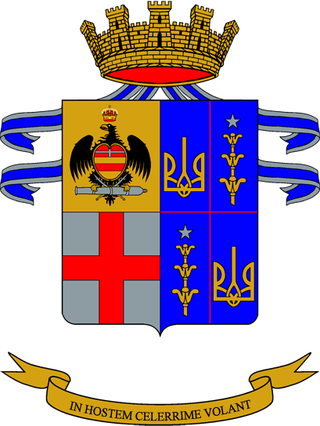Related Research Articles

The Italian front was one of the main theatres of war of World War I. It involved a series of military engagements along the border between the Kingdom of Italy and Austria-Hungary from 1915 to 1918. Following secret promises made by the Allies in the 1915 Treaty of London, the Kingdom of Italy entered the war on the Allied side, aiming to annex the Austrian Littoral, northern Dalmatia and the territories of present-day Trentino and South Tyrol. The front soon bogged down into trench warfare, similar to that on the Western Front, but at high altitudes and with extremely cold winters. Fighting along the front displaced much of the local population, and several thousand civilians died from malnutrition and illness in Italian and Austro-Hungarian refugee camps.
The following units of the German First Army and British Expeditionary Force fought in the Battle of Mons in World War I.
The Order of battle of the East African campaign shows the ground forces of both sides in East Africa on the date that the Italians declared war on Britain and France, 10 June 1940 and for the British and Commonwealth forces involved in the 1941 offensive.

The 5th Infantry Division "Cosseria" was an infantry division of the Royal Italian Army during World War II. The Cosseria was named for the Battle of Cosseria fought in 1796 during the War of the First Coalition. The division recruited primarily in Liguria and its infantry regiments were based in Ventimiglia (89th) and Genoa (90th), while the artillery regiment was based in Albenga.

The British Expeditionary Force order of battle 1914, as originally despatched to France in August and September 1914, at the beginning of World War I. The British Army prior to World War I traced its origins to the increasing demands of imperial expansion together with inefficiencies highlighted during the Crimean War, which led to the Cardwell and Childers Reforms of the late 19th century. These gave the British Army its modern shape, and defined its regimental system. The Haldane Reforms of 1907 formally created an Expeditionary force and the Territorial Force.

The 60th Infantry Division "Sabratha" was an infantry division of the Royal Italian Army during World War II. The Sabratha was raised in May 1937, in Gharyan in Italian Libya and named after the nearby ancient Roman city of Sabratha. The division's regimental depots were in mainland Italy in Campania and shared with the 25th Infantry Division "Bologna", with both divisions recruiting their troops from and training them there. The division was destroyed on 25 July 1942 during the First Battle of El Alamein in Egypt and its remnants used to fill up the depleted ranks of the 102nd Motorized Division "Trento". The Sabratha was classified as an auto-transportable division, meaning it had some motorized transport, but not enough to move the entire division at once.
XXVII Brigade, Royal Field Artillery was a brigade of the Royal Field Artillery which served in the First World War.
XXIX Brigade, Royal Field Artillery was a brigade of the Royal Field Artillery which served in the First World War.
XXX (Howitzer) Brigade, Royal Field Artillery was a brigade of the Royal Field Artillery which served in the First World War.
XXXVII (Howitzer) Brigade, Royal Field Artillery was a brigade of the Royal Field Artillery which served in the First World War.
XL Brigade, Royal Field Artillery was a brigade of the Royal Field Artillery which served in the First World War.
XLII Brigade, Royal Field Artillery was a brigade of the Royal Field Artillery which served in the First World War.
XXXIV Brigade, Royal Field Artillery was a brigade of the Royal Field Artillery which served in the First World War.
XXXV Brigade, Royal Field Artillery was a brigade of the Royal Field Artillery which served in the First World War.

The Cavalry Brigade "Pozzuolo del Friuli" is a brigade of the Italian Army, based in the Friuli-Venezia Giulia and Veneto regions. The Brigade consists of a command unit, a cavalry regiment, an amphibious infantry regiment, an artillery regiment, an engineer regiment and a logistic regiment.

The Guards Division was an infantry division of the British Army that was formed in the Great War in France in 1915 from battalions of the Guards regiments from the Regular Army. The division served on the Western Front for the duration of the First World War. The division's insignia was the "All Seeing Eye".

The 2nd Infantry Brigade Combat Team, 34th Infantry Division is an Iowa Army National Guard unit headquartered in Boone, Iowa.
The Northamptonshire Battery, Royal Field Artillery was a unit of Britain's Territorial Force from 1908 to 1919. It served in the Sinai and Palestine Campaign during World War I. In World War II the battery fought in the Malayan Campaign and was captured at the Fall of Singapore.
V Battery Royal Horse Artillery was a battery of the Royal Horse Artillery. Formed in 1804, the battery took part in the Napoleonic Wars – notably the Peninsular War and Battle of Waterloo – before being placed into suspended animation in 1816 as part of the usual post-war reductions of the British Army.

The Field Artillery Regiment "a Cavallo" is a field artillery regiment of the Italian Army. The regiment carries and maintains the traditions of all Royal Sardinian Army, Royal Italian Army and Italian Army horse artillery units and includes a historic section with horse-drawn guns. The Royal Sardinian Army formed the first horse batteries in 1831, which in 1887 were merged to create the Horse Artillery Regiment. In World War I the regiment's batteries were assigned to the Royal Italian Army's four cavalry divisions, which fought on the Italian front.
References
- ↑ "The Royal Artillery". Ministry of Defence (United Kingdom). Archived from the original on 23 October 2013. Retrieved 13 April 2013.
- ↑ Baker, Chris. "What was an artillery brigade?". The Long, Long Trail. Retrieved 13 April 2013.
- ↑ "Rare WW1 North Russia (Murmansk Command) Military Medal, British War Medal & Victory Medal Group of Three - Signaller H. Edwards, 16/32nd Bde, 86th Bty. Royal Field Artillery". cultmancollectibles.com. Retrieved 7 October 2024.
A rare North Russia MM group with original citation awarded to 224969 Signaller Harry Edwards, Royal Field Artillery.